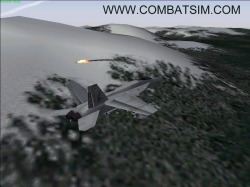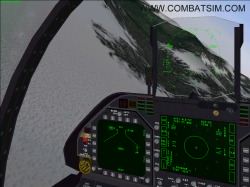|
(I/ITSEC) Conference Part II
by Eric Larson, LT USN January 12th, 2000 |
||||
|
I noticed that as I moved the cursor over contacts in the RWS display (or TWS, couldn't tell), a whole host of information sprung up around that particular contact. Missile launch parameters; altitude, airspeed, etc; all in yellow, too. All without actually designating the contact. A lot of things actually happen automatically. Very nice. Also, cursor movement is variable. When you push hard on the button the cursor moves *fast*. Kinda got out of control at first. But you also had very fine control as well. A very nice feel. The cursor itself is rather large - the parallel lines are almost half an inch long. And they are thinner than I expected as well. The cursor itself is yellow while all other symbology is initially green. As for sounds, there was no sound of the slipstream at all. Even when the gear was lowered or flaps or airbrake were deployed. But their *deployment* was audible. In fact, lowering the gear gave quite a solid "thump" if I remember correctly. The engine *could* be heard, but you had to focus on it - it was barely audible, even in afterburner. Missiles shots did make a sound (I described that audible sequence above). Also, and this would come under sounds and AI - there was no interaction whatsoever with anything remotely resembling ATC. No AI radio comms at all. Sounds from other aircraft weren't discernable. Moving on to weapons modeling, after the missile is launched you are presented with a missile trail that is made of solids - no alpha blending techniques like we are used to. Upon impact, the target image is replaced with a white cloud image and a few (3-5) triangular pieces of debris fly back at your aircraft - unnaturally fast (Believe me, you could just "tell" that debris motion was scripted and not physics-based. The debris would sit still for a moment then "zing" backward at you). The pilots preferred to be in TWS mode so that multiple AMRAAMs could be launched. I wasn't fast enough on the buttonology and HOTAS to call up radar modes and get multiple A120s off, but that was what they were trying to get me to do. When down on the deck there wasn't a huge rush of motion like many of us think we should see. I've heard people carping about the lack of a "sense of speed" in Janes F-15. Comparing my experience in J's F-15 and what I saw in the sim - I wouldn't fault Janes too much. Maybe you have to be *really* down in the weeds to get that sense - I don't know. All I can say is this isn't Battlestar Gallactica... After flying around, splashing the six other aircraft and a short little navigation segment, the Nellis AFB complex appeared beneath the nose. Made a hard right descending turn to the downwind and started slowing down to make the base leg turn in to the approach (no breaks allowed - apparently USAF doesn't allow that! >:-S jk!). Still on the downwind and a little high and fast, I was directed to make a slicing turn back toward the runway. Boards out and gear coming down, I was also directed to lower the hook (why, I don't know - just following orders at this point). My turn was a little tight so I angled toward the extended centerline. Engine control was smooth and timely - very short spool-up time and adequate power to control the VV. The aircraft was very stable on approach - no problems whatsoever. |
 Discussing touchdown with the pilot at my elbow, we decided to put it down without a flare (Naval aviators announce their arrival with authority!" remember? ;D). With a solid "bump" and accompanying kick in the pants (force-feel seat, remember) the main gear connected and the nose gear followed shortly thereafter. No bounces this time, either, I am proud to report! Feet on top of the pedals and a hard push for maximum braking, throttle to idle and stick full aft - it took a LONG time to get slowed down! I would have liked to turn it around and take off again, but there were others in line. The techs secured the program and I started unbuckling (a simple affair that only involved a quick twist of a knob on the front of the star connection that connected all the straps). Great fun - hope I can get another ride soon! :D Another notable exhibit was present at I/ITSEC: Janes Information Group and the two computers at their booth. USAF was on one machine and (regrettably) for the first day I never really took notice of the other one. There was a *remote* possibility that F-18 would be out, but I didn't consider it to be a realistic probability, thus didn't pay much attention. I happened to be walking by the booth on the second day and noticed something that reminded me of Janes F-15: The MPD display at the end of a mission prompting the user to end the simulation. Recalling that F-18 was made by the same folks that built F-15, I couldn't help doing a double take. Imagine if you were just walking by a computer among a thousand other people and you saw Janes F-18! And you were the only one there who appreciated the significance of what you were seeing!
 I went straight to the keyboard and got past the MPD screen - sure enough! Hot DAWG! What a find! And... no one else there seemed to even notice or care - F/A-18E all to my lonesome. Soon I met Scott Higgins and we started talking. Go to Page 4.
|
|||
|
Copyright © 1997 - 2000 COMBATSIM.COM, INC. All Rights Reserved. Last Updated January 10th, 1999 |
||||
